
pushrod suspension explained
rv1890 - 12/4/06 at 12:09 AM
Is there a book or a website that explains pushrod front supensions in detail??? I recently purchased Caroll Smiths book "Engineer to Win",
and it doesnt really explain pushrod suspensions. I need a book or website that explains the choice of suspension link lengths, attachment point
positions, and wishbone angles must be made, along with the layout. I was looking at the book called "Race car vehicle dynamics", but didnt
want to buy it unless its going to help. Thanks guys,.
v8kid - 12/4/06 at 06:53 AM
If thats the book by Milliken and Milleken buy it without doubt its the best suspension book I have ever read.
I'll check my copy tonight to see how much depth it covers push/pull rod suspension
nitram38 - 12/4/06 at 08:39 AM
Just remember some basic geometry.
Think about pivots (see saws?) and angles. If you make uneven pivots you can increase the effort or decrease the effort depending on which way around
they are. Keep angles equal. If the wisbone is 90 degrees to a pivot, make the shock 90 degrees to the pivot.
If it is 45 then make the other 45.
My suspension only moves an inch so the angles are not that critical as long as 1 inch of pushrod movement transfers to 1 inch of shock travel.
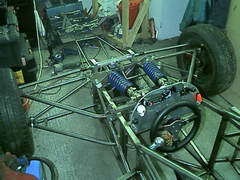

Description
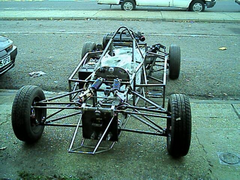

Description


Description
[img][/img]
[Edited on 12/4/2006 by nitram38]
rv1890 - 12/4/06 at 05:10 PM
That all sounds great, but where can I find mathematical reasoning behind that???. Lets say for instance I had (2) identical suspensions both setup
with 90 degree pivot points as mentioned. If one of the suspensions had a 200 lb spring rate and the other a 150 lb spring rate wouldnt the suspension
travel differ.
I guess what Im asking is where are the calculations that explain to me that if I use a "x" lb spring, with a "x" inch length
pushrod, mounted at "x" degrees on the pivot point = "x" amount of suspension travel. X being variable depending on the size of my
chassis.
Am I asking the wrong thing or is there a book or web site that explains this. Thanks guys
nitram38 - 12/4/06 at 05:22 PM
When you build your car, unless you actually know the finished weight, then calculating spring rates will be the same whether pushrod or normal
suspension.
If your pivots are one to one, then the springs will be the same as a normal car with non-pivot suspension.
I built mine with the reasoning that springs can be changed.
I would suggest that you fit a 'dummy' shock in the form of a solid bar until the car is ready or put a shock and guess a spring rate.
Springs are a matter of choice, once you have driven the car.
Unless your car has been built before, then you will probably have to change the springs anyway.
rv1890 - 12/4/06 at 06:54 PM
Ok Nitram, your advice has been very helpful, and Im going to pick your brain a little further.
Your idea about building it with a dummy shock and spring make sense, but what about mounting locations. Some shocks have varying distances between
the mounting holes. I myself cant afford the luxury of trying on one spring and then changing to another if it doesnt work properly. I also dont want
to to have to reweld mounting locations for the shock sand buy new springs until I find the one I need. What would you suggest here??
Where can I refer to if I want to find the closest spring rate according to the weight of my vehicle and driver. I want to buy the book "race car
vehicle dynamics" but dont want to spend the 100 dollars if it does not contain the info. I need.
rv1890 - 12/4/06 at 06:58 PM
You know what??.....after rereading your statements and discussing with a friend of mine it has become more clear what you were saying. You can
disregard the last message.
but is that book still what I need??
nitram38 - 12/4/06 at 07:06 PM
I just built mine as I went. I put the pivots in place with tack welds. I then attached a shock and worked out where it would connect to the chassis
without binding or hitting everything. Last I attached the pushrods and fixed the pushrod mount on the wishbone.
Things to make your life easy are having the pusrods with left and righthand threads so that you can extend it without removal (like a track-rod
end).
Also I bought mounts for the shock that have a welded bush one side and a big hole on the other. They came with a bush that fits in the big hole and
a bolt.
When you tighten these, it allows you to centre the rods/shocks easily.
[img][/img]
Liam - 12/4/06 at 11:08 PM
There's no reason why you should have to guess a spring rate and change it once you've driven the car. You can design your suspension for a
natural wheel rate (cycles per minute) of your choice. Pushrods dont have to be any harder to design than normal wishbones or rockers like mine -
it's just a matter of calculating how much your shock is going to move compared to how much your wheel moves. Just basic leverage and
geometry.
Yes, everything you need is in the super expensive Milliken and Milliken book, but that is very heavy on maths and theory. Really does have
absolutely everything related to designing and buildig a race car though. For you I'd recommend the Race And Rally Car Source Book by Allan
Staniforth. This deals with the same topics in a much more accesable and practical way, and is as detailed as you really need to design a simple
suspension. The RARCSB deals with all aspects of car design - the same author also has a suspension specific book called Competition Car Suspension.
Haven't read this myself as the RARCSB contained everything I needed to design my suspension.
Hope that helps,
Liam
rv1890 - 13/4/06 at 02:07 AM
Sounds a lot more logical. Ill look into that book and see what I find. Thanks.
chriscook - 13/4/06 at 08:05 AM
Have you also considered pullrod suspension? The rod can be smaller/lighter as it is always in tension and therefore can't buckle.
Chris
(sorry to to add more confusion)
MikeRJ - 13/4/06 at 10:09 AM
quote:
Originally posted by nitram38

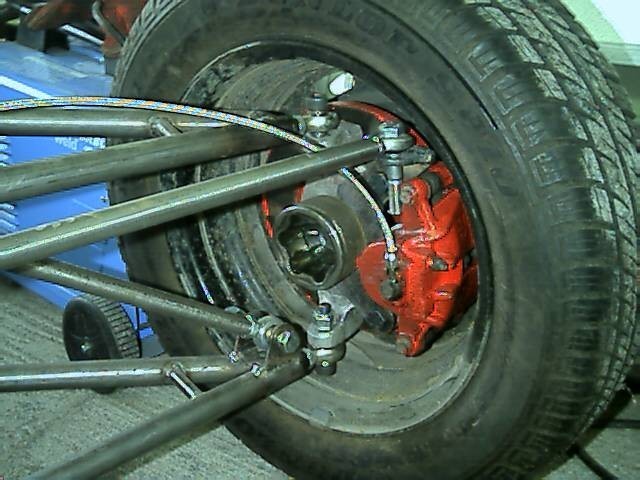
Description
Is it safe to load the rod end on the lower wishbone in that way? The weight of the car is trying to pull out the ball in the weakest plane...
nitram38 - 13/4/06 at 10:23 AM
Which rod end are you talking about, the one on the pushrod or the one on the wishbone?
If you are talking about the wishbone one, take a look at a formula renault suspension:

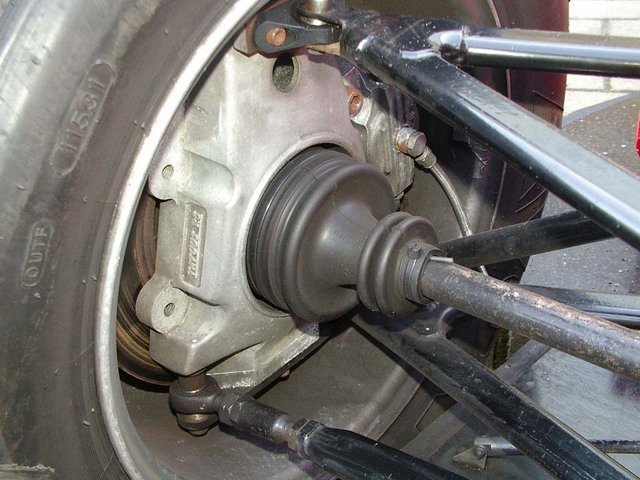
Description
[Edited on 13/4/2006 by nitram38]
Peteff - 13/4/06 at 11:53 AM
Do standard gas shock absorbers work horizontally? Years ago we were warned that they would not function properly unless mounted in the correct
orientation, i.e. with the top facing upwards and would need different shocks because of the valving.
nitram38 - 13/4/06 at 11:58 AM
I am using GAZ shocks and they work fine, although they are horizontal and slighty tilted down towards the top mounts. They do not leak and operate
normally. 
wildchild - 13/4/06 at 12:11 PM
quote:
Originally posted by chriscook
Have you also considered pullrod suspension? The rod can be smaller/lighter as it is always in tension and therefore can't buckle.
Chris
(sorry to to add more confusion)
presumably works with a rod from the outboard end of the top 'bone to somewhere down in the bottom of the car?
chriscook - 13/4/06 at 01:52 PM
Yes thats right. Puts the dampers down low in the chassis for lower CofG too. But they are less accessable for adjustment..
quote:
Originally posted by wildchild
presumably works with a rod from the outboard end of the top 'bone to somewhere down in the bottom of the car?
wildchild - 13/4/06 at 02:12 PM
interesting.
i'd never really considered using inboard shocks till I read this thread, but it's got some interesting possibilities.
if nothing else it would stop your shocks getting coated in road crud 
I might have to have a more serious look at this idea.
Tralfaz - 13/4/06 at 05:47 PM
quote:
Originally posted by nitram38
If you are talking about the wishbone one, take a look at a formula renault suspension:


Description
[Edited on 13/4/2006 by nitram38]
That's just the toe link visible, no? Lower wishbone end is hidden behind the drive axle boot
nitram38 - 13/4/06 at 06:50 PM
The picture is off a rear suspension and the other one is a rod end too. The fronts are the same.
You just have to make sure that you buy the right rod ends. There are some cheap ones that cannot withstand high loads.
eddymcclements - 13/4/06 at 09:29 PM
In the Formula Renault design you've illustrated the rod-end is sandwiched between the casting above and a hefty steel plate below. If the ball
pops out of its housing the joint will at least remain captive on the bolt passing through the rod-end while the driver slows down and halts.
Cheers,
Eddy
nitram38 - 13/4/06 at 10:17 PM
quote:
Originally posted by eddymcclements
In the Formula Renault design you've illustrated the rod-end is sandwiched between the casting above and a hefty steel plate below. If the ball
pops out of its housing the joint will at least remain captive on the bolt passing through the rod-end while the driver slows down and halts.
Cheers,
Eddy
Impossible to do on front suspension as it is a turning point, but if you could see closer in my photo, you would be able to see a wedge shaped spacer
that does the same job.
Also the main reason the sandwich plate is there has more to do with a stud fixing in the aluminium (not a bolt right through) and the bar gives it
more strength.
Most formula renault rod ends and captive bearings have copper inserts that break away during a shunt to save the uprights.
There are lots of cars using rod ends in this way.
Check out: http://www.pegasusautoracing.com/productselection.asp?Product=3068
[Edited on 13/4/2006 by nitram38]
nitram38 - 14/4/06 at 10:45 PM
If it is good enough for the atom, it is good enough for me! 

C10CoryM - 15/4/06 at 01:10 AM
OK, Im a dummy. Where is the invisible safety washer in that pic? Usually its a large one on the outside. Ive never seen any other type.
nitram38 - 15/4/06 at 07:56 AM
quote:
Originally posted by C10CoryM
OK, Im a dummy. Where is the invisible safety washer in that pic? Usually its a large one on the outside. Ive never seen any other type.
There are none!
jono_misfit - 15/4/06 at 10:45 AM
If you look at many single seaters they have similar style mountings for rod end.
Personally i dislike single shear mounts as you put a bending load into the point where the bolt enters the fixing. The load on the bolts is often a
lot higher when there bending and shear rather than just sheer (like in a double sheer mount).
Hillclimb cars seem to use single sheer mounts with woefull abandon and few seem to run safety washers.
Still hilclimb you wont bump wheels and if you touch a bank thats likely to cause more than a ball to pop from the joint.
C10CoryM - 15/4/06 at 04:37 PM
Ya, no one likes single shear, but it does get used a lot without failing  .
.
Around here safety washers are absolutely mandatory to race. Maybe due to the heavy weight and the higher torque of cars rod end failures are more
common here. I would never consider running anything without safety washers. Then again, I am well known for breaking stuff  .
.
Cheers
nitram38 - 15/4/06 at 05:24 PM
I had to buy mine from the USA, because I can't find them over here!
Someone will probably tell me where now! 
rv1890 - 16/4/06 at 03:02 AM
Finally!! I found what I need. The Race And Rally Car Source Book by Allan Staniforth. Thanks Liam for recommending it earler in this thread. It
explains a good amount of the things I needed to know when this thread started. This book explains straight forward the understandings of build a good
race car. Highly recommended. Thanks again .
rv1890 - 16/4/06 at 03:04 AM
Oh and one more thing. Hey Nitram do you have a web site showing your build??.. When I click on ur www it send me to your web cam deal. Thanks.
nitram38 - 16/4/06 at 05:31 AM
quote:
Originally posted by rv1890
Oh and one more thing. Hey Nitram do you have a web site showing your build??.. When I click on ur www it send me to your web cam deal. Thanks.
Not at the moment.
I am in the process of changing broadband provider, but I will set something up.
I will probably sell my car within a few months of the sva as I have my heart set on another build!
I fancy making an 'atom' style car with the chassis as the body. 
nitram38 - 26/4/06 at 02:23 PM
I managed to take a photo of the Rod End safety Washer. I bought them from a supplier in the US called Pegasus Racing.
And before anyone says anything, the suspension is in droop, so the rose joint is supposed to be at that angle! 
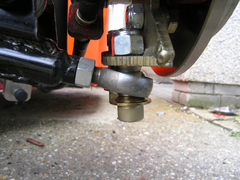

Description
[Edited on 26/4/2006 by nitram38]






